Beyond mere aesthetics, cloudy water poses risks to aquatic life due to spikes in ammonia levels, increased acidity, and oxygen depletion. Understanding the mechanisms behind cloudy water is crucial for maintaining a healthy aquatic environment. This article explores solutions—from mindful feeding and substrate cleaning to the use of UV sterilizers—aquarists can effectively use to address and prevent cloudy water.

So you’ve just set up your new fish tank and, at first, it had perfect crystal clear water. However, after a couple of days, the aquarium water becomes cloudy white, seemingly out of nowhere.
You have no idea why this happened and it’s getting so bad that you can no longer see your fish clearly.
What you’re witnessing is likely caused by a bacterial bloom, which is typical for new fish tanks. Typically, the cloudiness is the result of too many nutrients in the water or an interrupted Nitrogen cycle.
However, this could also happen in an established tank and the cloudiness usually appears after you’ve changed a portion of the water.
If so, is there a permanent fix?
To clear the cloudy aquarium water and make it crystal clear again you need to learn why it became this way in the first place.
Why Did Cloudy Fish Tank Water Appear?
The underlying causes of cloudy aquarium water vary but the mechanism that is triggered is almost always the same.
In 9 out of 10 cases, bacterial blooms may be at fault:
The water in a fish tank may become cloudy due to a large bacterial bloom. Specific bacteria, known as Heterotrophic, consume excess organic nutrients in the system and multiply in the process. Blooms typically happen in new aquariums that are going through the Nitrogen cycle for the first time.
In brand new fish tanks, bacterial colonies are still establishing their hierarchy.
The cloudy water in such cases usually forms a day or two after setting up the aquarium, even with no fish present.
The bacteria responsible for the cloudiness have the ability to double their population every 15 minutes.
This eventually causes a big bloom, and the water in the tank becomes white and foggy from their sheer numbers, seemingly overnight.
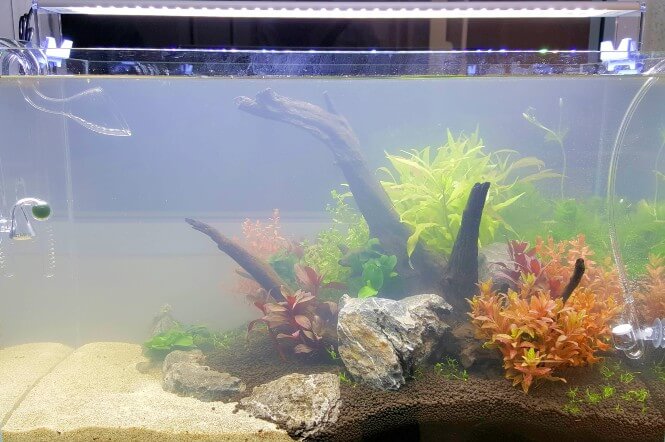
Some less common reasons behind cloudy water are:
- the presence of microbubbles;
- a chemical precipitate;
- dust from an unwashed substrate such as gravel.
Leaving cloudy water to clear itself naturally is possible but it will take many weeks, or, in some cases, months. However, with the help of something like a UV water sterilizer the water could clear up in just 5 days.
If there is a green tint to the water and it looks somewhat foggy, it will not be addressed by any of the above.
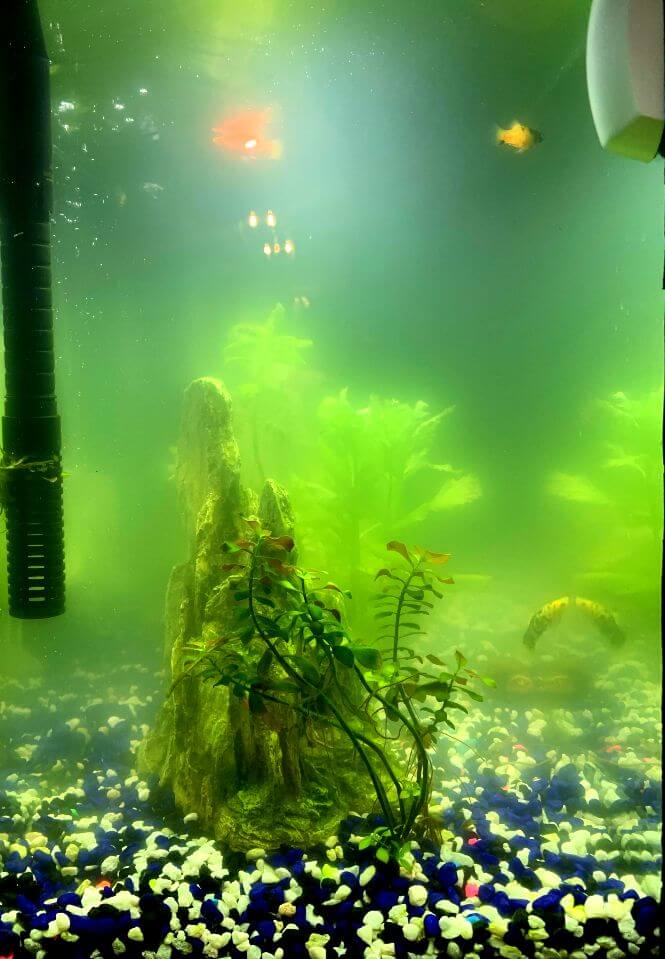
This type of cloudy green water is likely caused by a microalgae bloom.
Is the cloudy water safe for pet fish or will it hurt them?
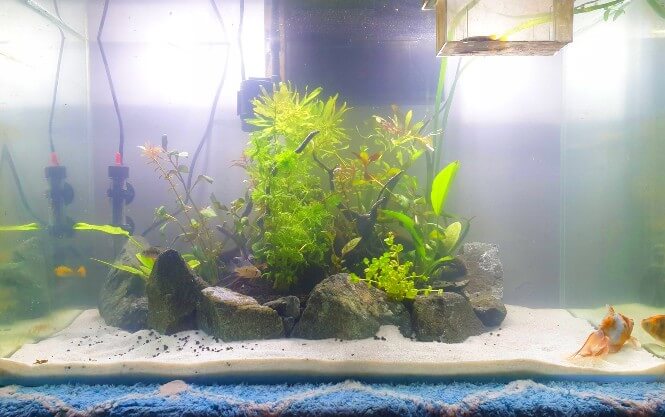
A cloudy aquarium may mean the pet fish inside are not safe.
When Heterotrophic bacteria bloom they convert higher amounts of organic matter than usual. Consequently, this process may cause a spike in ammonia levels in the aquarium’s water while quickly increasing its acidity.
Both of these conditions are known to be lethal to aquarium fish and other aquatic animals. Essentially it is not the cloudy water that’s hurting or killing fish, but rather the swings in the water parameters.
Moreover, during a bacterial bloom, the Heterotrophic bacteria also take up a lot of oxygen from the water.
As you can see there are more than one reasons for aquarium fish to be dying when your new tank’s water becomes cloudy:
- High Ammonia levels – Often, a bacterial bloom is combined with fish randomly dying or showing signs that they are about to die soon. If that’s the case, it’s very likely that the cause of the mortalities is rotting organic matter in the water.
The cloudy water could mean a dead fish has gone unnoticed, or leftover food has been stuck in the substrate.
Dying leaves of aquatic plant matter can also raise the Ammonia levels in the water. If you find that the ammonia levels are dangerously high, which is anything above 0.25 ppm, it could be a clever move to add bottled beneficial bacteria to the water in order to lower them.
This will kickstart the establishment of the colonies required to oxidize the Ammonia into the much less harmful Nitrate.
It’s worth mentioning that sometimes the Ammonia readings may remain at 0 ppm while the water is still cloudy.
This may be because there are enough live aquatic plants in the tank to take advantage of the excess inorganics (the Ammonia).
Aquatic plants prefer Ammonia as their primary source of Nitrogen for growth and will take it over Nitrate when it is readily available.
If the fish tank is not planted, but the ammonia readings still remain at 0 PPM, the bloom was most likely caused by the organics introduced to the system via a water change.
In that case, the release of Ammonia is negligible.
- Increased water acidity – One of the reasons for performing on-going water changes in our aquariums, aside from removing a bunch of Nitrate, is to also keep the acidity of the water in check.
Bacterial activity will steadily lower the pH value of the water with time.
Most fish can endure a steady change in water acidity.
However, during a bacterial bloom that’s severe enough to make the water visibly cloudy, the acidity of the water may begin to increase too quickly.
What’s important to remember here is that water acidity changes on a logarithmic scale.
This means that 6 pH is 10 times more acidic than 7 pH, and 100 times more acidic than 8 pH.
Sudden pH drops, such as the ones caused by heavy bacterial blooms can be lethal to both freshwater and hardy saltwater fish.
The more fragile aquatic inhabitants in the tank may perish because the pH swing could prove too severe for them to handle.
- Oxygen deprivation – During their process of decomposing organics, the Heterotrophic bacteria use up the oxygen in the water.
Usually, the used amounts are negligible in established aquariums with a stable Nitrogen cycle going on.
However, during a bloom event, the competition for oxygen between bacteria and fish becomes vicious.
The denser the milky look of the water is – the more severe the problem becomes.
You may witness your pet fish gasping for air at the top of the water’s surface.
As a side note: in these scenarios, it’s crucial that you follow the instructions on your water conditioner. Water conditioners also use up oxygen when they detoxify tap water.
Anyway, this is one of those cases where installing a UV sterilizer in your aquarium would be adequate.
I’ll talk more about this below, but the jist of it is that the UV sterilizer will eradicate most of the bacteria in a couple of hours, whereas waiting for the bloom to sort itself out could sometimes take weeks.
Don’t forget that in the meantime you can increase the water’s surface agitation to allow for quicker and more effective oxygenation.
The risk of fish suffocating during a bacterial bloom in smaller aquariums or bowls is much higher because of the compact water volume.
5 Different Types of Cloudy Aquarium Water Explained
Let’s take a detailed look at each of the different types of water cloudiness in a fish tank:
- Excessive amount of organic nutrients – Healthy aquarium water will have all kinds of bacterial colonies to support it and feed off its nutrient content.
The water of a new aquarium may become cloudy because some of the establishing bacterial colonies are blooming faster than others.
Here’s why – aquatic bacteria are divided into 2 general types:
- heterotrophic bacteria;
- autotrophic bacteria. The former prefer to consume organic matter to survive, while the latter can synthesize their own food from inorganic compounds.In an aquarium, heterotrophs will decompose the organics in the water.The decomposing process is called remineralization.Carbon dioxide (CO2), Ammonia (NH3), Phosphate, and Nitrate (NO3-) are released through the remineralization process.
- Each time you feed your fish, the food that doesn’t get eaten sinks down to the bottom of the tank where it starts to degrade.
- Each time an aquatic inhabitant produces waste, it remains inside the ecosystem and starts to decompose.
- Rotting flesh of both untrimmed aquatic plants and dead fish.
- The tap water used in most of the new freshwater aquariums. Organics-rich tap water is the reason why some new aquarium systems are becoming visibly cloudy, even if there are no fish present.
- Microbubbles from a filter – Occasionally, Hang-On-Back aquarium filters or protein skimmers can produce millions of microscopic air bubbles in the water, therefore making it hazy white.
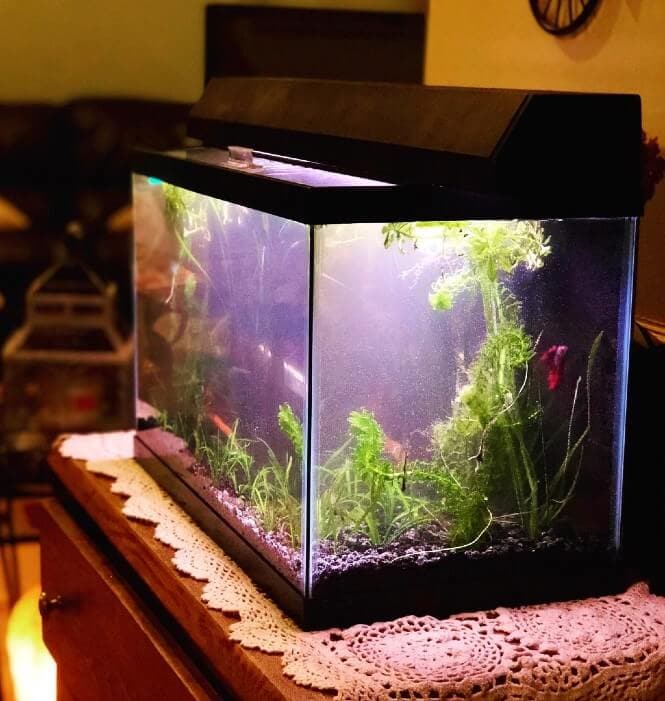
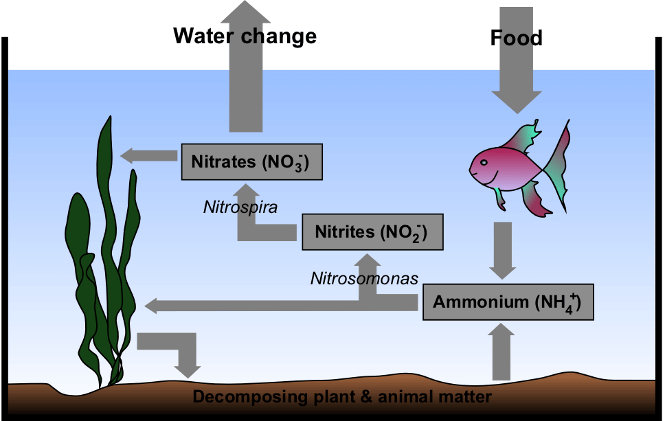 The Ammonia will then get picked up by the autotrophs which will convert it to Nitrites (NO2-) and Nitrate in a process called nitrification.
The Ammonia will then get picked up by the autotrophs which will convert it to Nitrites (NO2-) and Nitrate in a process called nitrification.Autotrophs are the beneficial biofilter in an aquarium.They are the ones protecting the aquatic animals from Ammonia or Nitrite poisoning.That being said, the bacteria responsible for the cloudy water in your new aquarium are the heterotrophs.Heterotrophic bacteria can reproduce at a relatively fast pace. They can multiply each 15 to 60 minutes while the autotrophs take between 16 and 24 hours to double in numbers.This means that heterotrophic bacteria are realistically able to completely overpopulate the water in a tank overnight.Following these thoughts, whenever there’s an excess of organics in the aquarium’s water the heterotrophic bacteria will aggressively multiply to decompose them.This happens so fast that they are unable to attach themselves to surfaces and instead saturate the water column, causing it to appear cloudy to the naked eye.Here are the common sources of organic nutrients in a home aquarium:
If you doubt that your HOB filter may be the culprit, it’s worth turning it off and waiting for an hour or so.
If it was the filter’s fault you’ll notice an improving water clarity in that period.
Anyway, a faulty build of the filter does not necessarily imply that it will not be able to filtrate the water correctly.
It’s worth noting that, rarely, microbubble clouds in the water also appear with a canister filter if its tubing is not properly connected.
Anyhow, in a saltwater aquarium the usual suspect behind cloudy water, that’s full of microbubbles, would be the protein skimmer.
A protein skimmer does that as part of its job – it produces microbubbles on purpose.
However, sometimes the build of the unit may not be flawless. This could cause a leak of microbubbles right back in the fish tank, which could make the water look very foggy.
How dangerous microbubbles are to the fish depends on the severity of the issue.
The bubbles need to be addressed as soon as possible. If they’re severe enough to cause cloudiness, large amounts of them can suffocate a fish by clogging up its gills.
Otherwise, Calcium Carbonate (CaCO3) could precipitate, forming small white particles that will eventually fill up the aquarium’s water and cover the interior.

By lapin
Most aquarium substrates such as sand and gravel will be dirty out of the bag.
I recommend thoroughly rinsing your new substrate or you risk dealing with hazy aquarium water for weeks.
Typically, you’d see the water becoming slightly cloudy right after feeding your fish.
This type of cloudiness would be the same color as the fish food you’re using.
This is not ideal because these fine food particles don’t get eaten by your pet fish and eventually become food for bacteria.
This in turn could lead to a bacterial bloom causing the water to, again, become cloudy white.
How to Clear Cloudy Aquarium Water (a Bacterial Bloom) For Good?
To make the water in your aquarium perfectly transparent again you should investigate if there’s an imbalance in the fish tank’s Nitrogen cycle.
The solutions will change depending on the trigger, but I will outline some standard tools and techniques that will work once the problem is identified.
Try these methods to clear up the cloudy water in your aquarium:
Feed your fish mindfully, and keep the aquarium’s substrate clean to eliminate the excess nutrients that may be causing bacteria to bloom. Also, improving the mechanical and biological filtration of the water is one of the most reliable ways to quickly make it crystal clear again.
1. Set up a UV water sterilizer.
Using a UV sterilizer is one of the fastest and most efficient ways to clear cloudy aquarium water.
Here in this photo you can see the dramatic improvement in water clarity, by using a UV sterilizer for 1 week:

The way a UltraViolet sterilizer works is by circulating the bacteria-infested aquarium water through a narrow tube with a UV lamp inside.
The lamp in said tube emits UV light, bombarding the bacteria’s DNA with high-energy particles.
This process causes mutations that prevent the bacteria from multiplying further. In effect, the bacterial balance in the water column is quickly restored, clearing up the cloudiness.
I’d only recommend getting a UV sterilizer when you’d like to treat a case of foggy water that has been going on for weeks or months.
If the water in your aquarium keeps getting cloudy for this long, then, perhaps, an outside intervention to forcefully restore the bacterial balance is needed.

Another situation that justifies getting a UV water filter is when your freshwater aquarium, or reef tank, is so cloudy that you can barely see through it.
I’m talking about a dense, milky white appearance.
A UV light sterilizer will rid your tank’s water of cloudiness in a matter of days (and sometimes hours).
Other methods usually take weeks or even months to start showing results.
For most hobbyists, the overall cost of a single UV water filter is worth the long-term benefits it provides for their aquariums.
By getting one you’ll have immediate control over future bacteria blooms, and outbreaks of free-floating algae spores (causing the aquarium water to become cloudy AND green).
For example, here’s another snapshot showing how effective UV water filters can be at clarifying aquarium water:

Anyway, you can also periodically run a UV sterilizer as a successful preventive measure against different nasty fish parasites, such as both the freshwater and marine versions of Ich.
UV water sterilizers are also commonly used in many hobbyists’ quarantine tanks, meant for monitoring new fish coming from the store.
To quickly fix the issue with cloudy water, however, you’ll need to know the Wattage of the UV lamp that would best suit your aquarium’s volume.
Author’s Note: A UV sterilizer with a 9 Watt bulb such as the AA Green Killing Machine will work wonderfully in any fish tank that holds between 20 and 55 gallons of water. You can find this 9-Watt UV sterilizer at Chewy.com and Amazon.com, just to name a few online vendors.
For fish tanks of 20 gallons or under, I recommend the 3 Watt version. Click here to check it out on Chewy or here for an Amazon.com link.
If you’d like to go more in-depth I recommend checking out the Aquanswers guide on UV sterilizers.
Visit the link to check which product has the right UV lamp and GPH (Gallons Per Hour) rate to clear up the water in your aquarium the quickest.
2. Vacuum 35% of the substrate every 3 days until it’s fully clean.
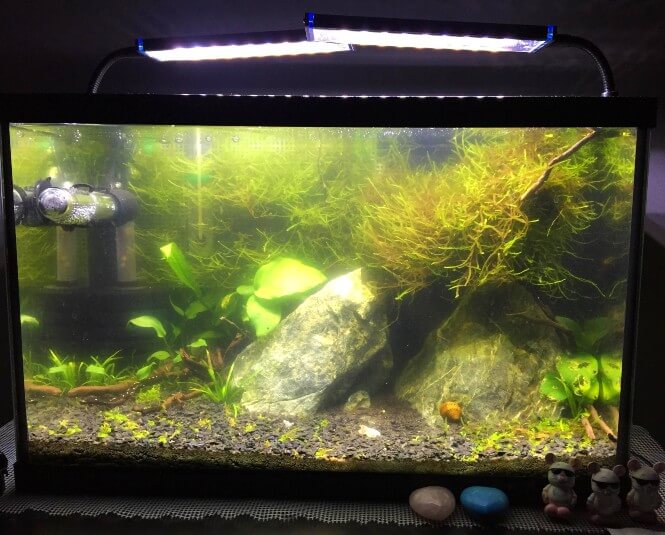
By PandabearXp
This course of action only applies as a solution to established aquariums that have long gone through the cycling process but are still struggling with cloudy water.
Why would you clean 1/3 of the substrate but not the whole thing though?
To answer this question I first need to point out why you should be vacuuming the substrate.
Excess organic nutrients are sometimes the result of too much decomposing fish poop or uneaten food that got stuck in the substrate.
So to get rid of the bacterial bloom and make the water crystal clear you’d need to remove the food source these bacteria are consuming in order to multiply.
In my experience, the easiest way to do this is with a gravel vacuum such as this one, or any other similar device you can find in pet stores.
But here comes the caveat.
The beneficial bacteria – the ones you actually want to have in abundance in your aquarium – also live primarily on surfaces.
This could completely stall the Nitrogen cycle and you’ll end up back at point zero with, again, a cloudy aquarium.
Therefore I recommend that you vacuum 35% of the substrate and wait for 3 days in between cleaning sessions. This way you give the good bacteria a chance to restore their lost colonies.
After the third day of the first cleaning, vacuum another 35%, and keep this sequence until you have the whole substrate cleaned.
I know that it sounds slow and tedious, but this is a safe and efficient way to restore the aquarium’s bacterial balance.
Author’s note: After you’re done it could still take another week or two for the water to become completely clear.
3. Feed your fish every other day.
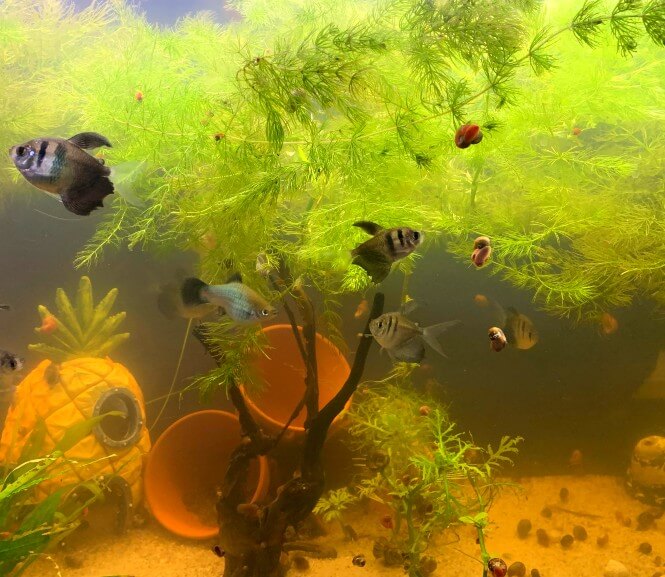
Sometimes, even if you managed to rid your fish tank of cloudy water with something that works fast like a UV sterilizer, the cloudiness returns.
The most common reason for an aquarium that keeps getting cloudy is a fish owner that keeps overfeeding their fish.
It’s often that inexperienced pet parents feed their fish with more food than needed.
I used to be the same and justified doing so with fear of my little pet fish going too hungry.
To battle endless cloudy water you’d want to manage how much you feed your fish, without going over the top.
Same as the previous method, this one also applies to people who are struggling with cloudy white water in their already-cycled aquarium.
Long story short, fish are relatively hardy and a healthy specimen can skip eating a meal for at least a week, without adverse effects.
This is because in the wild you can’t expect to eat a juicy amount of bloodworm or algae wafers on a daily basis.
For this reason, it’s likely better to feed less than what your Betta fish or Goldfish can force itself to eat.
This way you’ll limit the food sources for the bacteria and the water may begin clearing up in the next couple of days.
Here’s a good general guide on the recommended fish feeding frequency for you to check out.
Author’s Note: A bacterial bloom caused by overfeeding your fish can arise between 1 and 2 days after the leftovers were left to sit in the aquarium’s substrate. Usually, the bacteria are in their peak numbers, at the end of the first day.
Anyway, for optimal resutls this method is best combined with vacuuming the substrate of the tank.
4. Perform smaller water changes with Reverse Osmosis Water.
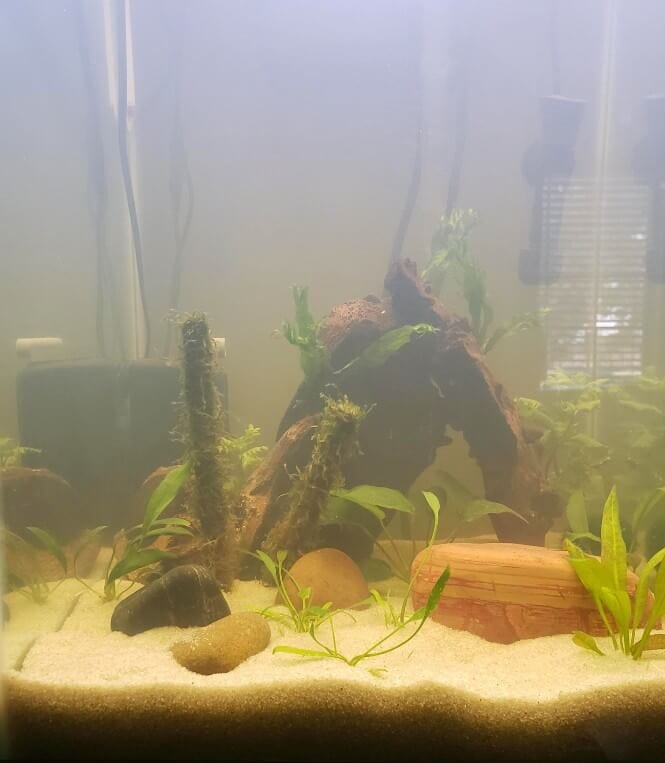
By dawgs311
This section applies to people who are trying to clear the water in a freshwater aquarium that continuously gets foggy after a water change.
I’m saying freshwater because almost all saltwater aquarium keepers already use RO water in their tanks.
Anyway, part of the problem here is that water changes larger than 10 to 15% can disrupt the biological balance in the water column, and give advantages to some bacteria over others.
This is precisely why you may see your fish tank getting cloudy after a water change:
When you change a portion of the aquarium’s water with a new batch of dechlorinated tap water, heterotrophic bacteria in the tank start feeding directly from the water column, blooming in the process. This is because dechlorinating tap water makes it bacteria-friendly. Tap water also has organic compounds in it, which are the main nutritional source for heterotrophic bacteria in an aquarium. The bacteria multiply so fast and in such vast numbers that they overpopulate the water visibly.
Therefore, if you’d like to prevent your fish tank from getting cloudy after each water change you should likely interchange the water source you’re using.
A good substitute for the nutrient-rich tap water would be water that has gone through Reverse Osmosis.
The process of Reverse Osmosis removes the organic compounds from the water.
Beyond this, there are even studies suggesting that a portion of heterotrophs manage to survive in chlorinated water.
This means that you may be actually inviting more of these bacteria to your aquarium during a water change with tap water.
Anyway, the process of RO filtration also removes the beneficial minerals from the water, and most aquatic inhabitants get their minerals through their skin and gills.
There are two products with the minerals fish need that I have been really happy with.
One is called Equilibrium and the other is Replenish.
You can easily find both products in your local fish store or online.
Replenish is targeted towards bare-bottom tanks filled with community fish, whereas Equilibrium works better for remineralizing water in planted aquariums.
Anyway, I do have some experience with RO water filters and one of the cheaper ones I ended up buying was this budget-friendly unit (link to see it on Chewy.com, but Amazon also has it).
I’m fairly pleased with it.
I also have a complete guide on RO/DI water systems, and though it’s suited towards reef tanks, the listed units will work just as well for a freshwater aquarium.
It’s worth noting that fish stores may also sell RO water for a set price per gallon.
Though this seems fine, let’s assume for a moment that you have a 55-gallon tank and you change roughly 20% of its water each week.
In this example, you can do the math and you’ll see that in approximately 3 months the RO water filter will pay for itself.
This means that In the long run, it makes more sense to get your own RO water filter than to buy ready-made from the fish store.
5. Change your aquarium salt mix.

By MillsReef
This method is targeted toward saltwater tank keepers so if you’re not one of them, go over to section number 7.
Anyway, sometimes we want to diversify and try out new options when mixing our reef tank’s water.
There are two types of aquarium salt mixes that can fog up the water in a saltwater tank.
The first one is probiotic salts, which contain live bacteria.
These, when used in small water changes of under 10%, are okay and won’t cause water clouding.
However, when used in a larger water change, there’s a significant chance that the probiotic salt causes a bacterial bloom in the tank.
The other type of aquarium salt mix that may take some time to clear from the water column is the one that simply needs more time to dissipate.
These will likely have it mentioned on the instructions label if it’s normal for the water to become a hazy white color during mixing.
6. Sprinkle Epsom salt before adding a salt mix.
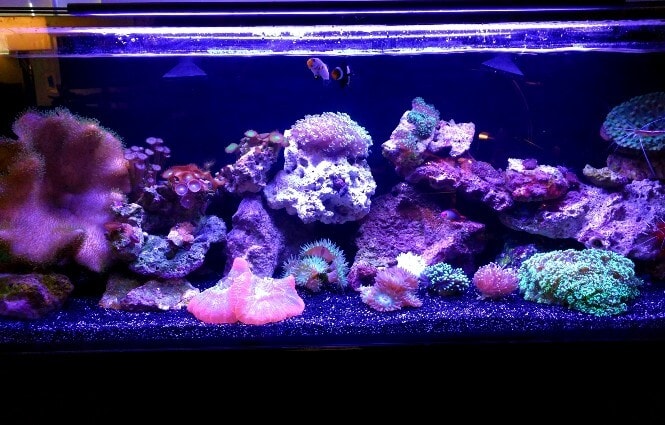
By Learjet45dream
This method is again for people with saltwater aquariums and reef tanks.
Did your aquarium’s water become cloudy white right after you added the salt mix to the RO/DI water?
And does the white coloration actually comes from particles that look like tiny snowflakes?
That’s most likely a form of Calcium Carbonate precipitation.
I did some tedious research and it turns out that this effect occurs because of some rather complex chemical reactions.
To simplify it: whenever you’re mixing water for your saltwater tank, you’d want the RO/DI water to have enough Magnesium before adding the salt mix.
If the salt mix settles or dissolves before the Magnesium the water ends up with a huge build-up of Calcium Carbonate.
The cheapest way I’ve found to add Magnesium to the mix is with Epsom salt.
Epsom salt is Magnesium Sulfate (MgSO4) in its nature.
My experience with it has been that it’s a rather slow dissolver and it needs a bit of stirring.
There’s another Magnesium alternative that dissolves in seconds but it is also a bit pricier than Epsom salt.
That would be Magnesium Chloride (MgCl2), which is not easily findable over the counter, so here’s a link to it on Amazon.
It’s worth noting that sometimes the intrinsically interlinked pH, kH, and Calcium content in a typical saltwater aquarium can be in a “supersaturated state” which again would produce white precipitation.
To look behind the equations, I suggest that you read this article.
Anyway, this very simple trick effectively prevents the Calcium Carbonate precipitate in your saltwater aquarium.
7. Filter the water through Polyester filter floss media.

By coconutofcuriosity
Filter floss on its own is an excellent tool to expedite the process of clearing up the cloudy water in your fish tank. It is best combined with other methods and it works in both saltwater and freshwater systems.
It clears up any excess detritus very well as long as it’s changed regularly.
In fact, Polyester fiberfill is one of the best filter media for mechanical water filtration in an aquarium system overall.
In the case of microbubbles or an unsettled sandy substrate, a good portion of filter floss media may solve the problem entirely.
The mechanical filtration provided by the microfibers is enough of a wall to partially filter out bacteria if that’s causing the water’s fogginess.
Filter floss is definitely a good addition to any tank and should be a mainstay to secure water clarity even after the cloudiness has disappeared.
Note that this will not solve the underlying problems behind the cloudy water, but it will act as a relatively quick and efficient way to make it crystal clear.
Just be sure to change the floss pads every couple of days.
8. Use a different aquarium substrate.
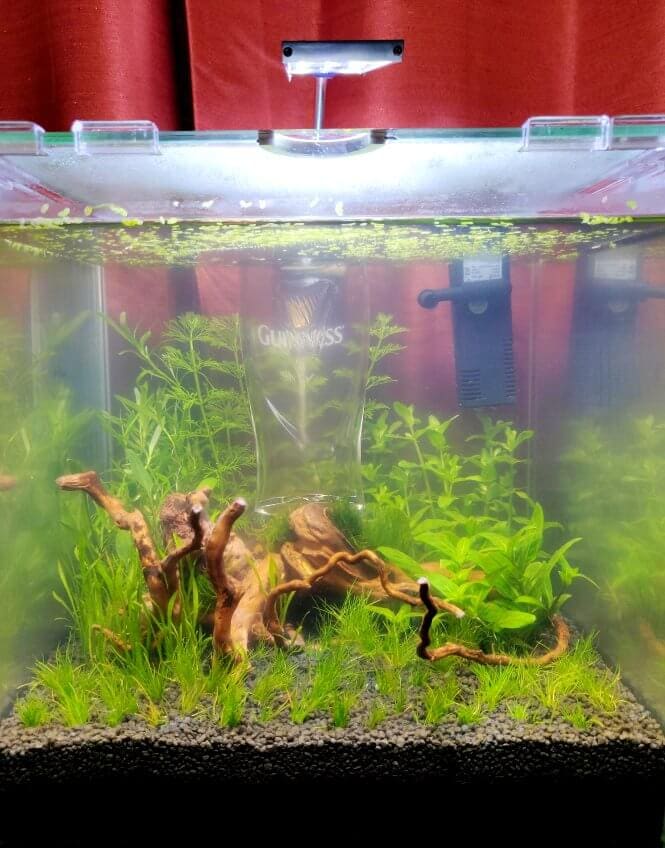
By ThisIsBuzzard
Certain types of substrates can end up dissolved within the aquarium’s water, creating a murky or foggy environment.
Aqua Soils used in freshwater planted tanks, for example, deplete with time. That’s because they’re designed to provide live plants with vital nutrients for maximizing growth potential.
However, these substrates are often messy and can turn your aquarium water into a “dirted” version of itself.
Some hobbyists do this on purpose in order to simulate the brown waters of the natural biotope of their pet fish.
However, most people that are new to fishkeeping should likely go with an inert substrate that has a beautiful appearance to it.
Inert substrates don’t deplete with time and remain stable in water.
The inert substrates often do the work for aesthetics, but some of them, if not thoroughly washed beforehand, can contribute to cloudy water with their fine particles.
This is normal to a certain extent and the water usually clears up on its own after the particles settle.
However, if a substrate with light weight is chosen it can take too long for it to settle in water. Even more so if you’re one of those chaotic aquarists that play around with their aquascape a bit too often.
In my personal experience using Black Diamond Blasting Sand works best as a decorative substrate.
It settles easily and it’s also heavy enough to not get stirred by enthusiastic fish movement or rearranging your tank’s aquascape.
On the other hand, it’s not that heavy to compact and crush a sensitive plant’s roots.
If you’d like to keep live aquatic plants in a nutrient-rich Aqua Soil, however, you should know what to pick from and how to avoid messing up the color of the water.
I’ve compiled a guide on planted tank substrates and aqua soils for you to check out.
9. Wait it out.

By filipinofirebomb
The Nitrogen cycle in new fish tanks has a break-in period during which bacterial imbalances can cause cloudiness issues within the water.
If not aided by external factors, such as the addition of bottled beneficial bacteria starters, said period could last for weeks.
This is a natural part of the ongoing establishment of an internal aquatic ecosystem.
If your aquarium is new and it has just been set up, then your most reliable course of action is to wait for the system to completely establish its Nitrogenous cycle.
Cloudy water, in this case, is a natural occurrence that may or may not happen, and getting rid of it requires no action on your part.
Usually, by the end of the “cycling” process, the water’s cloudiness will clear up on its own.
Use a liquid water test kit and measure the water’s parameters once every 2 days to check if the tank is still cycling.
Liquid water test kits are generally better at telling you the real numbers than test strips, which is why I recommend them.
A solid proof of an aquarium that’s still cycling are readings that show (in parts per million):
- More than 0 ppm of Ammonia
- More than 0 ppm of Nitrite
- 0 ppm of NitrAte
Even if only one of the aforementioned is true it’s to be considered as a signal for the ongoing establishment of bacterial colonies.
You should likely avoid disturbing the establishment of bacterial colonies during this time. During this period it’s generally not recommended to change the water of a cycling aquarium.
How to Prevent Cloudy Aquarium Water from Appearing Ever Again?
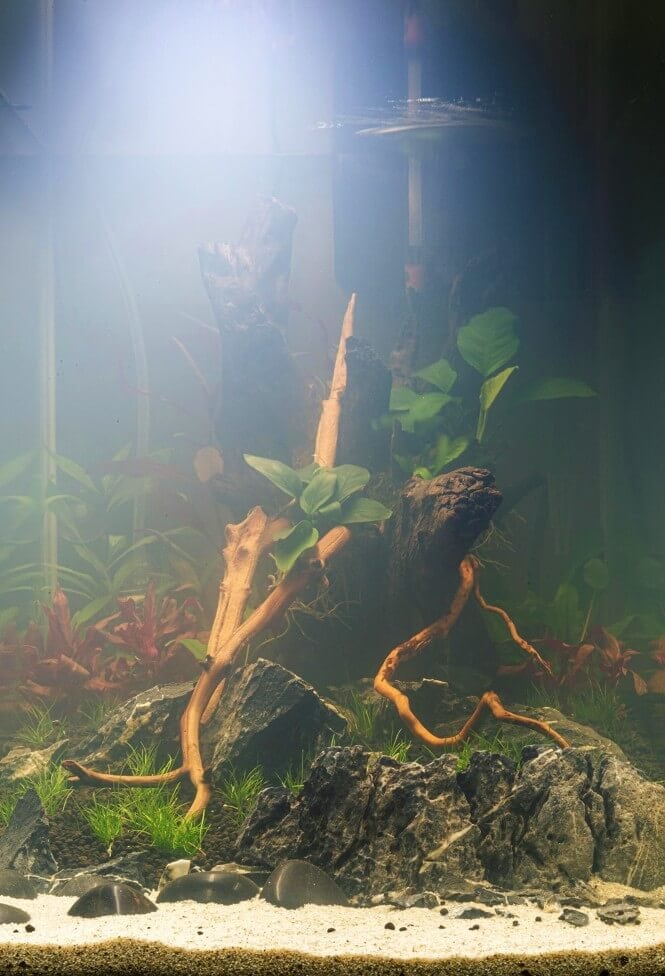
By Dylan King
Though certain natural processes in aquatic systems are inevitable, the damaging causes of cloudy water are entirely avoidable.
I strongly recommend that you follow this checklist once you get rid of the bacterial bloom.
Take a look at these tested ways to prevent fish tank water from becoming cloudy:
- Feed less than what you think the fish can eat.
From my observation, I’ve come to the conclusion that overfeeding is, perhaps, the number one reason behind any imbalance of nutrients in these closed ecosystems.
To keep everything in check you should feed less than what you think your fish could eat.
Be precise and try not to go over a set small portion of food or you risk making the water continuously cloudy.
If the meal sinks down to the bottom and your aquatic pets did not see it – don’t sprinkle another pinch.
If you do not trust yourself with precise dosing, you can get one of those cheap automatic fish feeders.
They will feed a pre-set portion of food on a set schedule, controlling the number of food leftovers and keeping the foggy water at bay.
Another advantage of having one is being able to go out of town without the need of asking other people to feed your fish, who may or may not overfeed as well.
I recommend Eheim’s fish feeder because it has done well by me and it’s also really durable.
- Clean parts of the substrate on a regular basis.
The aquarium’s substrate keeps most of the organic waste that could potentially bring out a cloudy appearance in the water column.
The solution here is to vacuum the substrate regularly, but don’t forget to only do a third of the whole thing at a time.
Another reason to regularly clean the substrate is that a dead fish may remain unnoticed. This is a sure way to shoot the bacterial and Ammonia levels up, causing water fogginess as a byproduct in the process.
- Change smaller portions of aquarium water.
The more dechlorinated, nutrient-rich tap water you pour down your aquarium, the more explosively the heterotrophic bacteria will multiply.
With a water change of no more than 10 to 15%, this will not happen.
At these ratios, the new water will not be enough to cause a dramatic difference in the available organic nutrients in a short period of time.
- Replace tap water with RO/DI water for water changes.
RO/DI water is purified from the excess nutrients that may cause both bacterial and algae blooms.
Even after dechlorination, the Heterotrophic bacteria will have no business in it, because it will lack food sources for them.
- Trim overgrown or rotting plant matter.
The yellowing or wilting aquatic plant matter is to be immediately trimmed when noticed.
Doing so is a reliable way to bring your planted tank back to stability.
- Add fewer new fish at a time.
Gradually overstocking a tank should not cause its water to become cloudy as long as you patiently add the new fish in small numbers.
However, if you add more than 3 medium-sized fish, relatively to your tank’s size, you are likely asking for a bacterial bloom to occur.
If you happen to own a small, 5-gallon aquarium, you can click here to check what fish and invertebrates would best fit in, without overwhelming the system.
- Filter the water through UV light regularly.
UV lights work by impeding the excessive presence of bacteria in the water column.
Not only does it work for clearing up the cloudy appearance of the water but it also is an excellent preventive measure against it.
UV light can be extremely effective to control Heterotrophs (the Ammonia producers).
Striving for crystal clear aquarium water
Cloudy water in the aquarium is easy to get rid of once you understand what you’re battling.
Your fish tank is host to much more than just fish, and runaway issues such as Heterotrophic bacterial blooms can indeed occur.
Assess the amount you feed to your aquatic pets, as excess food and waste are great for Ammonia-producing bacteria and bad for everything else.

Leave a comment below if you need more answers or want to share your experience with other readers of Aquanswers.

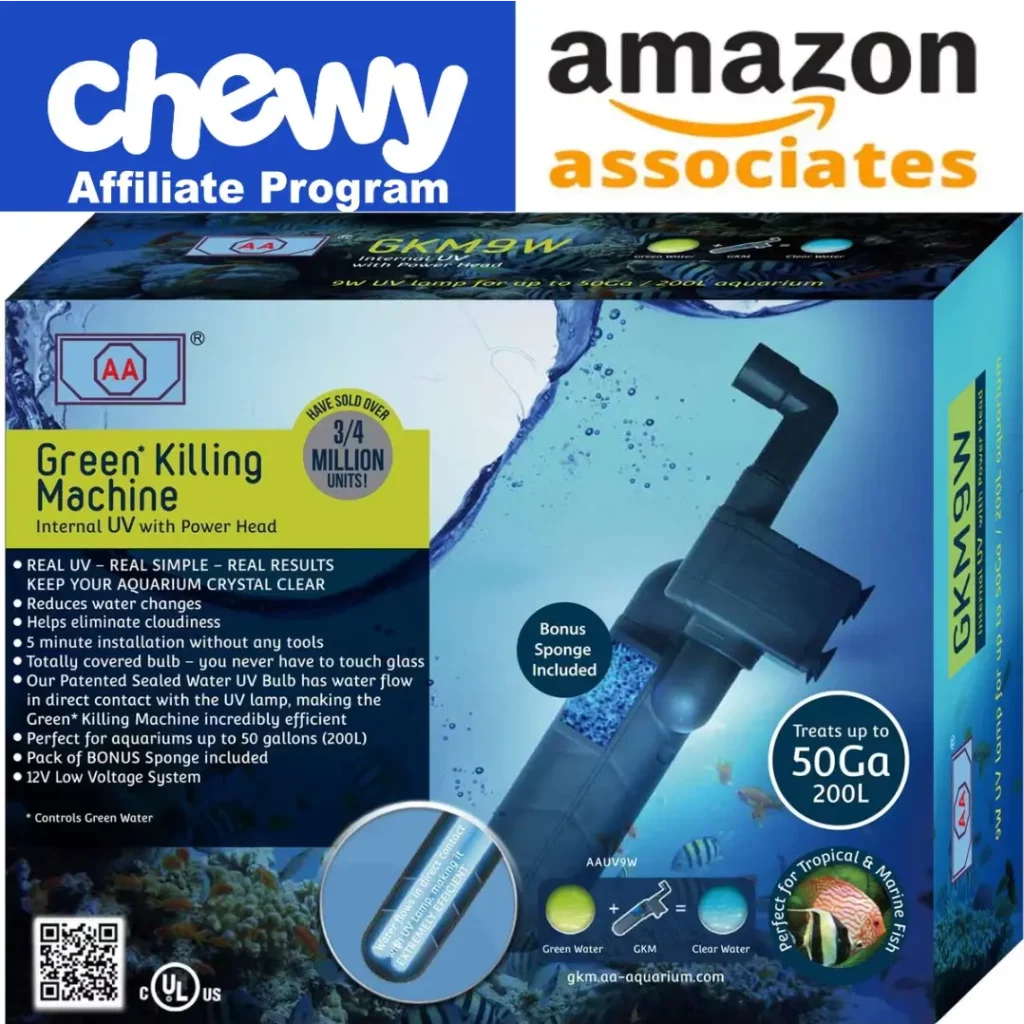
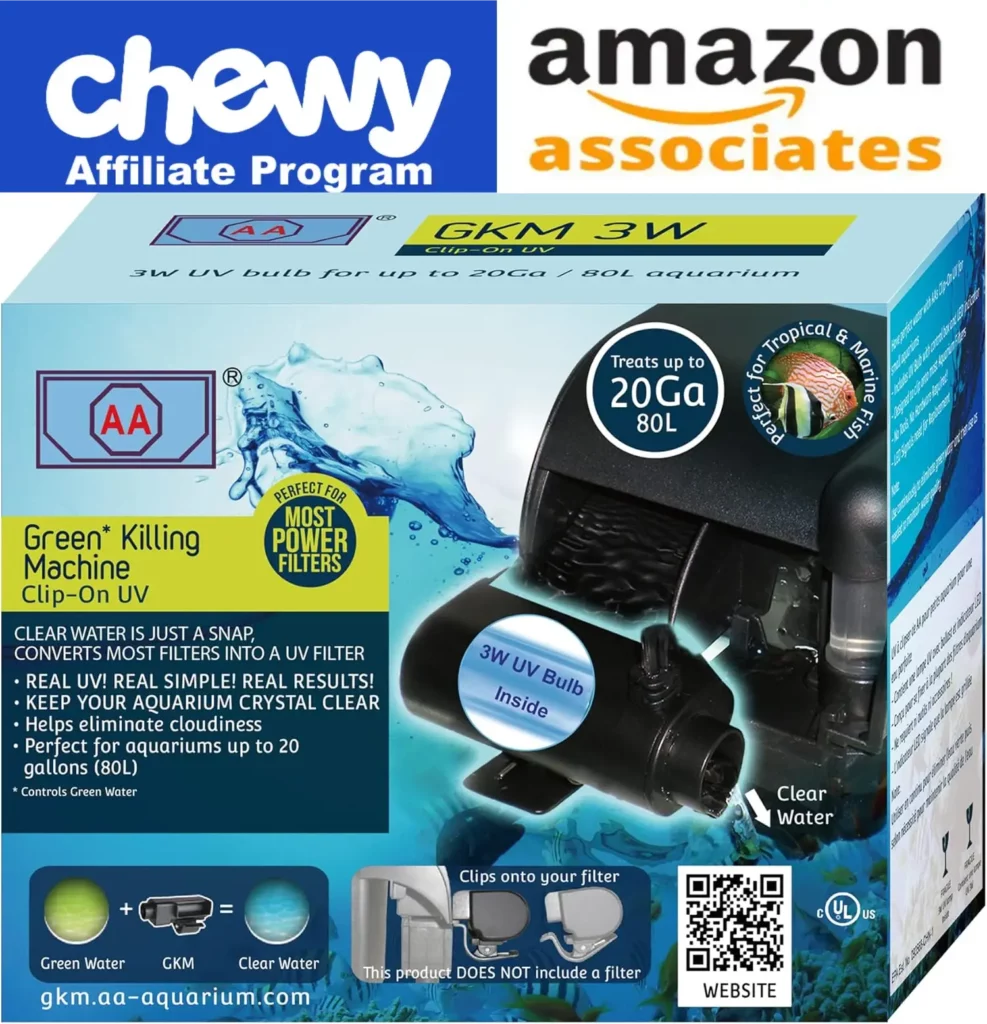
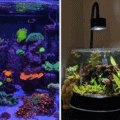

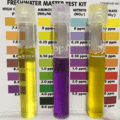




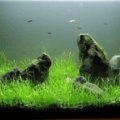


36 thoughts on “Cloudy Aquarium Water: Why it Happens and How to Clear it?”